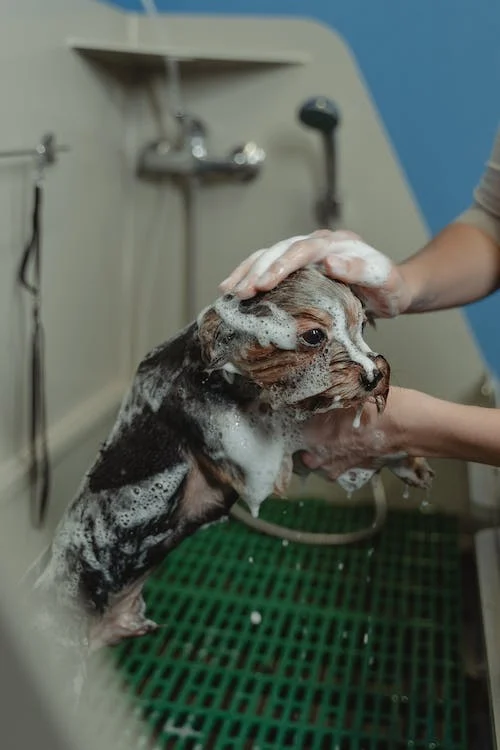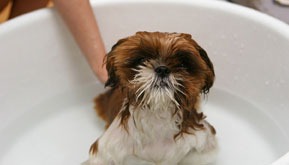Bath time is a relaxing and soothing time, but not for dogs. It’s one of the most caring and kindest acts of love you can show them but most likely, they won’t see it that way. They may feel like your torturing them or punishing them, so you need to exert some extra effort to make bath time more pleasant for both of you.
 Where to bathe your dog
Where to bathe your dog
Choose the most comfortable space wherein you can bathe your dog. Some dog owners install a raised tub in their home, making dog bathing easier on their backs, but most people don’t have the luxury of a special tub. If you have a small dog or puppy, you can bathe them in the kitchen sink or a laundry sink.
If your dog can’t fit in a sink, use your regular bathtub or shower. If your dog is really filthy during a sunny day, bathe him outside and use a garden hose. But don’t do this often – dog’s don’t like being cold, just like us, and they are not comfortable with having a hose shot at them. Meanwhile, if you happen to live in a truly pet-loving community, sometimes there are bath facilities provided, with a raised tub, bathing and grooming supplies similar to what you might find in at a pet groomer.
There’s no right or wrong place to bathe your dog, but the best location is in a room with a closed door. This can prevent a dog from fleeing from bath time while wet and nervous and spreading all their lovely wet dog smell everywhere.
General tips
These are some practical, helpful tips that can make bathing a dog easier and more efficient.
- Get the right shampoo. Don’t use your own shampoo, even your baby’s shampoo for cleansing your dog, because these have different pH that’s not appropriate for your dog. Dog shampoos are milder, with chlorhexidine as an active ingredient.
- If your dog has a skin condition, choose a special treatment shampoo. If you should have an issue with fleas, lather up with a pyrethrin-based shampoo.
- For dogs with itchy skin, you may use oatmeal shampoos or oatmeal-based products.
- You may use a leash or harness if you have to, but you have to give off a happy vibe so that your dog won’t feel like you’re punishing him or her.
- Give treats before, during and after bathing so that your dog will learn to look forward to it the next time. Who knows you may even get them to want a bath so they can get the treat.
- Keep a good cheery and an upbeat attitude. If your dog keeps on resisting bath time, don’t vent out your frustration – your angry voice won’t help. When your dog shows cooperation, keep on giving praise.
- Make bath time a fun time. Just like little children, dogs love toys on the bath. Choose those made of plastic, and better yet, pick those that clean the teeth as well.
Here are also some additional tips and recommendations on what to do before, during and after the puppy’s bath time:
Before bathing
- Brush your dog before wetting him. This will remove debris from your dog’s coat and helps work out mats in the hair. Matted hair happens especially for longer-haired dogs, and bath water tends to set in the mats, making it harder to remove. Pick them apart gently or cut them out before taking your dog to the bath.
- Before bathing your dog, make sure you already have all your supplies ready in the area where you are going to bathe him. Prepare the brush, shampoo, cotton balls and towel, as well as any detanglers, mineral oils, etc. Also, make sure you have your harness or leash (if you need these). In this way, you won’t be leaving the dog alone while he or she is already wet since this might make them frightened.
- Keep the bottom of the tub or floor from being too slippery. Dogs tend to be stressed out when not able to stand without sliding. Put a towel down so that he or she can have something to grip, or lay a rubber mat or any non-slip mat.
- Prevent the drain from clogging by putting a piece of steel wool in the drain. Dog hair might plug your drain, especially if your dog is really hairy.
- Have treats handy before bathing. This would help him cooperate and enjoy bathing.
- Prepare lukewarm water. Bath water for dogs should never be too cold or too hot to prevent shock, especially for puppies. Larger breed dogs can be bathed with cooler water because their bodies more easily overheat than smaller ones.
During bathing
- Test the water temperature first before wetting your dog. Once the temperature is fine, gently wet your dog completely from the fur to the skin. Soak your dog using a hose adapter, shower nozzle or plastic dipper.
- Shampoo the back of the ears to the neck down to his body, then to the tail and paws. Lather thoroughly.
- Avoid shampooing the head to keep the dog from ingesting the soap, and from irritating the shampoo from entering the eyes, nose, and ears. You only need to wipe his face using a damp cloth.
- Rinse well. Don’t let any soap be left in the fur because it might irritate the dog’s skin once it’s dry. Keep rinsing for some more even if the soap seems to be gone because soap tends to stay in the fur.
After bathing
- Wrap your dog in a towel to dry. Watch out for a shake off and let him do it for a few times.
- Air-dry or use or blow drier designed for dogs. Avoid using your blow drier because it will be too hot.
While bath time is dreaded by many dogs (and many owners as well), it can be transformed a fun session of owner-and-dog bonding. Just keep your cool and don’t lose heart; your dog will learn to keep calm and at least tolerate the bath.


 Where to bathe your dog
Where to bathe your dog